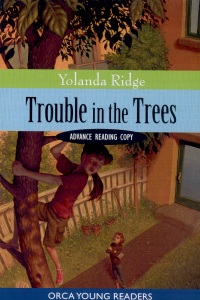| ________________
CM . . .
. Volume XVII Number 27. . . .March 18, 2011 
 |
Trouble in the Trees. (Orca Young Readers).
Yolanda Ridge.
Victoria, BC: Orca, 2011.
146 pp., pbk., $7.95.
ISBN 978-1-55469-385-6.
Grades 2-5 / Ages 7-10.
Review by Stacey Matson.
*** /4
Reviewed from Advance Reading Copy.
|
| |
|

excerpt:
I definitely didn't want Ms. Matheson to start thinking about Ethan's fall. I figured it would be game over if that happened. Truth was, although I'd had a few minor injuries from tree climbing, I'd never considered it dangerous. But what if Ethan had really been hurt? Would that have changed the way I felt about it? Could Ashley and everyone else be right about tree climbing- was it really that dangerous?
I was done in less than five minutes but it felt like forever. When I finished talking, Ms. Matheson thanked me again for coming. "We'll take your points into consideration."
"But..." I felt like things weren't complete, like I needed to say more. I wanted to scream, It's not fair! I love climbing trees. I'm not a grouchy old lady like Mrs. Leary! Please take me seriously!
Eleven-year-old Brianna Bridges is a master at climbing trees. She can scale the branches like a professional, and she does her best thinking high up in the leaves of her townhouse complex. Consequently, when a bylaw is passed banning tree climbing, enacted to protect the children of Cedar Grove, Bree is at a loss. She takes matters into her own hands with a presentation to the neighbourhood council. When her solo efforts don't work, Bree enlists the help of the other children in the community to fight back against an unfair bylaw that carries a hefty fine and the possibility of home foreclosure. Through protests through the neighbourhood and an "no bathing" rule, the children work out the most effective way to voice their opinions but to no avail. It is only when Bree finds a sneaky way around the rules that she can get back to doing what she loves best and gains the trust of the rest of the children in the complex. As Bree transfers her passion to others, the children focus their efforts in the right place to win while learning a few new negotiation skills at the same time.
Trouble in the Trees is Yolanda Ridge's first novel, and, as such, it's very strong. Bree is a likeable and round character, and her voice rings true as a child frustrated with the world of adults. All the child characters are distinct, and Ridge brings an honesty to their conversations and thoughts. Some of the strongest scenes in the book happen when the children get together to try and affect change; there is not complete agreement immediately, and each character's motivations and personality comes through in scenes of dialogue. The portrayals of relationships are realistic, and Ridge provides readers with a strong girl protagonist who is thoughtful and adventurous. Bree's sheer frustration of trying to affect change in the bylaw, alongside her confusion at the changing boy-girl relationships in her life, make the reader empathetic to her situation. It would have been more satisfying to see Bree emerge as a leader of the neighbourhood, since it feels that she is a leader from the beginning of the novel, but one does find some more satisfying character development in the character of Ethan, Bree's younger friend, whose fall from a tree is the initial cause of the bylaw.
The plot of the book moves quickly, and the chapters are short enough to engage early or reluctant readers. The language used in the book is simple and would be best suited to readers in grades two and three. There are some plot points that are sticky. For one, the punishment for climbing trees is extremely harsh. One violation costs $250, a second, $525. After three violations of the bylaw, the townhouse council can "sell your townhouse and keep the money." (p14) For one, this seems to be not only impossible, but also unrealistic, particularly for a bylaw that would be broken almost solely by children. Young readers may find this unbelievable, and if not, may worry about their own community bylaws and hefty fines. The tone of the book is generally engaging; however, at times it can sound rather didactic about the proper way to have your voice heard. This didactic tone is unnecessary as the story is strong enough to speak for itself as a learning tool without the message being delivered in a heavy-handed manner.
Recommended.
Stacey Matson has worked in educational and interpretive programming in cultural/historic sites across Canada. She is currently pursuing her MA in children's literature at the University of British Columbia.

To comment
on this title or this review, send mail to cm@umanitoba.ca.
Copyright © the Manitoba Library Association. Reproduction for personal
use is permitted only if this copyright notice is maintained. Any
other reproduction is prohibited without permission.
NEXT REVIEW |
TABLE OF CONTENTS FOR THIS ISSUE
- March 18, 2011.
AUTHORS |
TITLES |
MEDIA REVIEWS |
PROFILES |
BACK ISSUES |
SEARCH |
CMARCHIVE |
HOME |
